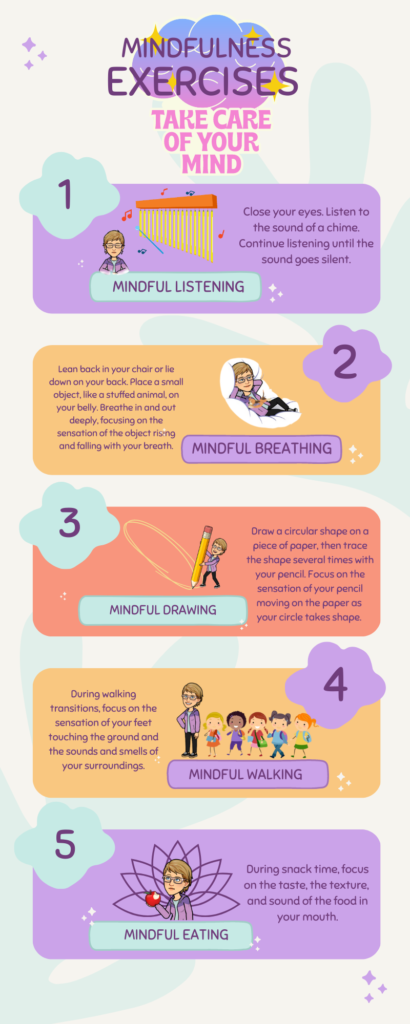Hey Teachers!
What if we told you that by doing nothing, your students could benefit greatly in the classroom? Sounds too good to be true, right? Well, it’s not. We’re talking about mindfulness, and it’s a practice that has proven to reduce problematic behaviors in the classroom while providing a host of other benefits for your students.
Mindfulness, also known as “the art of doing nothing,” is the practice of being present in the moment and aware of your thoughts, feelings, and surroundings without judgment. It can be done through a variety of techniques such as deep breathing, meditation, or simply focusing on your senses. And the benefits are significant.
The Benefits of Mindfulness in the Classroom
Studies have shown that incorporating mindfulness into the classroom can reduce stress, anxiety, and even depression in students. It can also improve focus, attention, and memory retention, making it easier for students to learn and retain information. Perhaps most importantly, mindfulness can reduce problematic behaviors in the classroom such as aggression, impulsivity, and hyperactivity.
Finding Time for Mindfulness Activities
Now, we know what you’re thinking. “I barely have enough time to get through my lesson plans as it is. How can I possibly add one more thing to my day?” But the truth is, mindfulness doesn’t have to be a time-consuming activity. In fact, it can be incorporated seamlessly into your daily routine, especially at the beginning of the day, after recess, and following related arts classes like art, music, or physical education.
When students are transitioning from one activity to another, it can be difficult for them to refocus and sustain attention. This is where mindfulness can be particularly helpful. By taking just a few minutes to practice mindfulness, you can help your students transition more smoothly and get back on task.
Calm vs. Boring
Keep in mind, at first students may find mindfulness “boring” as they are unaccustomed to feeling calm and peaceful. This is a natural reaction and it’s important to remind them that mindfulness is like a muscle that needs to be exercised regularly in order to see benefits.
Mindfulness Activities
Here are some simple and creative mindfulness activities to try with your students:
- Mindful Listening: Have students close their eyes and listen to a bell or a chime. Ask them to raise their hand when they can no longer hear the sound. This exercise helps students focus their attention on the present moment.
- Mindful Breathing: Have students lie down on their backs and place a small object, like a stuffed animal, on their belly. Ask them to breathe in and out deeply, focusing on the sensation of the object rising and falling with their breath.
- Mindful Drawing: Provide students with a blank piece of paper and have them simply draw a circular shape on it, then trace the shape several times with their pencil. Have them focus on the sensation of their pencil moving on the paper as their circle takes shape. Additional circles can be added if desired. Drawing and coloring circles has been shown to reduce stress, anxiety, and depression while promoting relaxation and creativity.
- Mindful Walking: While walking your students to and from the cafeteria, the playground, or related arts classes, encourage them to focus on the sensation of their feet touching the ground and the sounds and smells of their surroundings.
- Mindful Eating: During snack time, have students choose a small piece of food, like a raisin or a piece of chocolate, and eat it mindfully. Encourage them to focus on the taste, texture, and sensation of the food in their mouth.
Little Life Lessons • BIG Life Skills
Incorporating mindfulness into your classroom can have numerous benefits for your students and can actually make your job easier in the long run. By taking just a few minutes each day to practice the art of doing nothing, especially following transition times, you can help your students reduce stress, improve focus, and become more self-aware. So why not give it a try? Your students (and you) may be surprised by how much it can improve the classroom environment.
Watch a Mindfulness Lesson on YouTube
Books and Resources of this Topic:

A wonderful introduction to mindfulness for preschool and elementary school kids. The message is beautiful and teaches children how to be mindful and how to slow down in the moment. When feeling upset, it guides them to take a deep breath and say, “I am peace” and/or “Everything is alright.” This book and a few others from this author’s series are in our calming corner and the children gravitate to them.
Breathe Like a Bear: 30 Mindful Moments for Kids to Feel Calm and Focused Anytime, Anywhere
This is one of my all time favorite mindfulness resources. It is filled with beautifully illustrated mindfulness exercises to teach kids techniques for managing their bodies, breath, and emotions. With 30 exercises, you could have a new breathing exercise every week of the school year! Author, Kira Willey, has a YouTube channel with mindfulness songs that you will want to check out as well: https://www.youtube.com/@firefliesyoga/videos
This is a great book that teaches how to use a guided breathing pattern to calm worries, sadness, anger, and to enjoy happiness. It speaks directly to the reader and prompts them to blow their magic breath onto the book’s pages, while trying to visualize the replacement of unpleasant emotions and thoughts.
The simplicity of this book makes it easy for children to learn how to apply mindfulness in their daily lives for the multitude of emotions they experience. You can read the whole book through, or just pick a relevant emotion. I like the tips for adults at the end of the book to further help bring mindfulness to children. Highly recommend!
Relax Kids: Aladdin’s Magic Carpet and other Fairytale Meditations for Children
I am surprised that more elementary school counselors and teachers don’t know about this little treasure! Traditional fairy tales are used as a gentle and fun way of introducing children to the world of mindfulness and relaxation. Guided imagery and visualization will have children flying on Aladdin’s magic carpet, climbing Jack’s beanstalk, swimming in the ocean with the Little Mermaid, or listening to the sounds of the forest with Snow White. The stories are designed to encourage a child’s imagination while leading them into a positive and peaceful emotional state. A great little resources for the classroom or counseling office.
Ishi: Simple Tips from a Solid Friend
“Happiness is a choice. Be happy” is the essential message of this picture book.The author uses adorable photographs of a pet rock named Ishi to show kids (and adults) how to find the positive parts to life when they are feeling down, different, or lonely. She validates their feelings and then offers advice on how to find their inner peace and happiness.
Roll the dice and choose a pose to hold for a determined number of breaths. This simple movement game promotes stretching, flexibility, and focus. Perfect for brain breaks or mindful moments. Includes 36 poses to try!
Mindful Kids: 50 Mindfulness Activities for Kindness, Focus, and Calm
As a school counselor, I often use these with elementary students in the classroom, in small groups, or with individuals. These mindfulness exercises are short enough to keep their attention, phrased in ways that are kid-friendly, and teach a very important skill. There are also SO MANY, so I pick different ones to do for different kids based on their individual issues and how they are feeling. Once students are familiar with the activities, the cards could be added to a calm corner for students to access when they need a mindful moment.


